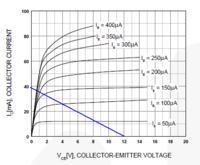micro_man
Newbie level 6
hi
its a basic question, but i want to know if i am doing write calculations or not
i want to drive a relay using bc547 transistor, relay has a coil resistance of 320 ohms, driving voltage is 12v. so the current required is 37.5mA.
after calculating all the others parameters i get the value of Rb=6.323kohms. Is it write? and is the transistor is in saturation region?

Also tell me how to read the graphs of the transistors and how to get help form these graphs?

thanks
its a basic question, but i want to know if i am doing write calculations or not
i want to drive a relay using bc547 transistor, relay has a coil resistance of 320 ohms, driving voltage is 12v. so the current required is 37.5mA.
after calculating all the others parameters i get the value of Rb=6.323kohms. Is it write? and is the transistor is in saturation region?

Also tell me how to read the graphs of the transistors and how to get help form these graphs?

thanks
Last edited by a moderator:
